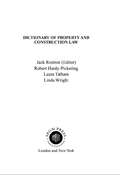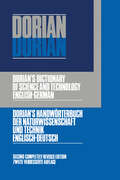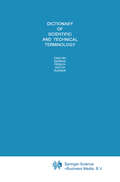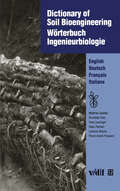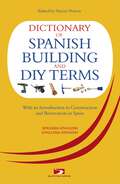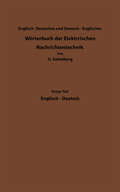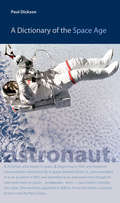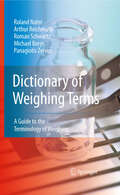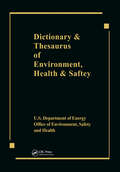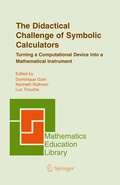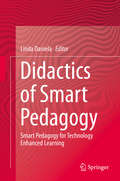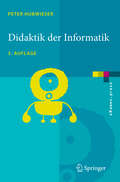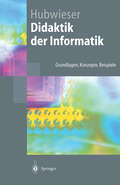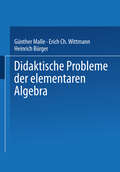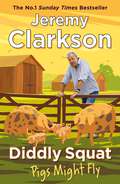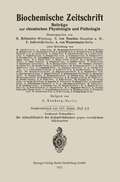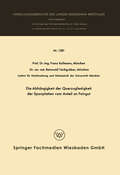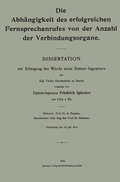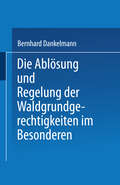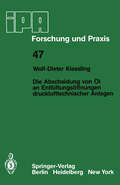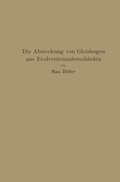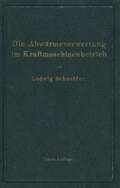- Table View
- List View
Dictionary of Property and Construction Law
by J. Rostron Robert Hardy-Pickering Laura Tatham Linda WrightThis is a new dictionary which provides a clear and concise explanation of terms used in land, property and construction law and management. The four key areas of coverage are: planning/construction law, land law, equity/trusts and finance and administration. It will be a useful reference for property and building professionals and a personal purchase for students of property and construction law on building, construction management, estate management and law courses.Jack Rostron is an experienced author and editor whose 1997 Spon title Sick Building Syndrome has been well received and widely reviewed. His co-authors contribute the necessary specialist knowledge from their respective fields of teaching and legal practice.
Dictionary of Science and Technology: English-German
by UNKNOWN AUTHORDorian's Dictionary of Science and Technology: English-German, Second Revised Edition focuses on the compilation of terms employed in science and technology. The book first takes a look at abduction, aberration, abhesion, abating, ablation, abscission, coupling, covering, back iron, cross-breeding, clip, cleats, channel, circuit diagram, connection, conveyors, and supercharger. The manuscript then takes a look at dabbing, dacite, dactyl, daffodil, damp, earmark, earphone, ripening, current prospecting, facilities, gaff, gablet, galaxy, gale, gait, gall, and galipot. The publication ponders on haddock, Hadley quadrant, H-bomb, habitation, habituation, hemoglobin, hailstorm, hail, halation, ichnography, iceboat, oblate, oblique, electrode structure, obesity, oatmeal, dyeing, and pachyderm. The text then explores wainscoting, waist, wale, waiver, ultrafilter, ultrahigh frequency, ulocarcinoma, elongation, vaccinal fever, vaccination, vaccine, vacancy, and vacuometer. The text is a dependable source of data for researchers interested in the terms used in science and technology.
Dictionary of Scientific and Technical Terminology: English German French Dutch Russian
by A. S. Markov V. A. Romanov V. I. Rydnik E. G. Rys V. M. Borsch S. N. Korchomkin N. S. Skorokhod Yu. V. Fedirko N. B. ShaykhonScientific and technical contacts between nations· have necessitated the publication of various language textbooks, manuals and reference books. Particularly important among them are multilingual scientifio and technical dictionaries. This English-German-French-Dutch-Russian Dictionary of Scientifio and Technical Terms contains some 9000 entries. The main fea ture of the Dictionary is that it includes first and foremost general scientific terms needed by an engineer working in any branch of science and technology. Besides, the Dictionary includes the basic terms used in physics, mathemat ics, the fundamentals of electrical engineering and chemistry, and also the most essential terms pertaining to manufacturing processes. machine design, testing methods, etc. The Compilers were confronted with a difficult task, as nowadays science and technology are developing rapidly and the minimum scientific and tech nical vocabulary required by a specialist is increasing accordingly. The Compilers have taken special pains to include the entire basic mod ern technical vocabulary, omitting superfluous words and phrases. They have tried to solve this problem by selecting mainly those scientific and tech nical terms which constitute the basic of a specialised vocabulary. There fore, the Dictionary includes the vocabulary pertaining to general study courses in mathematics, physics and chemistry, and also in electrical engi neering. electronics and machine design, given in technical colleges irrespect ive of their specification. This lends the Dictionary an «all-purpose» char acter, making it equally useful to scientists and engineers of different countries, who have graduated from colleges with different curricula.
Dictionary of Soil Bioengineering Wörterbuch Ingenieurbiologie: English/Deutsch/Français/Italiano
by Matthias Oplatka Matthias Dietz Yves Leuzinger Les Reussilles Fabio Palmeri Lorenzo Dibona Pierre-André FrossardA Dictionary of Spanish Building Terms: With an Introduction to Construction and Renovation in Spain
by David HarmanThis dictionary contains essential language for homeowners or tradesmen maintaining or renovating property in Spain. It contains the most up-to-date dictionary of Spanish building terms, including hundreds of technical words you won't find in a usual dictionary. Easy to use, this book will help you to communicate and avoid costly misunderstandings.
Dictionary of Technological Terms Used in Electrical Communication / Wörterbuch der Elektrischen Nachrichtentechnik
by Otto SattelbergDieser Buchtitel ist Teil des Digitalisierungsprojekts Springer Book Archives mit Publikationen, die seit den Anfängen des Verlags von 1842 erschienen sind. Der Verlag stellt mit diesem Archiv Quellen für die historische wie auch die disziplingeschichtliche Forschung zur Verfügung, die jeweils im historischen Kontext betrachtet werden müssen. Dieser Titel erschien in der Zeit vor 1945 und wird daher in seiner zeittypischen politisch-ideologischen Ausrichtung vom Verlag nicht beworben.
A Dictionary of the Space Age (New Series in NASA History (PDF))
by Paul DicksonThe launch of Sputnik 1 in 1957 ushered in an exciting era of scientific and technological advancement. As television news anchors, radio hosts, and journalists reported the happenings of the American and the Soviet space programs to millions of captivated citizens, words that belonged to the worlds of science, aviation, and science fiction suddenly became part of the colloquial language. What’s more, NASA used a litany of acronyms in much of its official correspondence in an effort to transmit as much information in as little time as possible. To translate this peculiar vocabulary, Paul Dickson has compiled the curious lingo and mystifying acronyms of NASA in an accessible dictionary of the names, words, and phrases of the Space Age.Aviators, fighter pilots, and test pilots coined the phrases "spam in a can" (how astronauts felt prelaunch as they sat in a tiny capsule atop a rocket booster); "tickety-boo" (things are fine), and "the Eagle has landed" (Neil Armstrong’s famous quote when Apollo 11 landed on the Moon).This dictionary captures a broader foundation for language of the Space Age based on the historic principles employed by the Oxford English Dictionary and Webster’s New Third International Dictionary. Word histories for major terms are detailed in a conversational tone, and technical terms are deciphered for the interested student and lay reader. This is a must-own reference for space history buffs.
A Dictionary of the Space Age (New Series in NASA History (PDF))
by Paul DicksonThe launch of Sputnik 1 in 1957 ushered in an exciting era of scientific and technological advancement. As television news anchors, radio hosts, and journalists reported the happenings of the American and the Soviet space programs to millions of captivated citizens, words that belonged to the worlds of science, aviation, and science fiction suddenly became part of the colloquial language. What’s more, NASA used a litany of acronyms in much of its official correspondence in an effort to transmit as much information in as little time as possible. To translate this peculiar vocabulary, Paul Dickson has compiled the curious lingo and mystifying acronyms of NASA in an accessible dictionary of the names, words, and phrases of the Space Age.Aviators, fighter pilots, and test pilots coined the phrases "spam in a can" (how astronauts felt prelaunch as they sat in a tiny capsule atop a rocket booster); "tickety-boo" (things are fine), and "the Eagle has landed" (Neil Armstrong’s famous quote when Apollo 11 landed on the Moon).This dictionary captures a broader foundation for language of the Space Age based on the historic principles employed by the Oxford English Dictionary and Webster’s New Third International Dictionary. Word histories for major terms are detailed in a conversational tone, and technical terms are deciphered for the interested student and lay reader. This is a must-own reference for space history buffs.
Dictionary of Weighing Terms: A Guide to the Terminology of Weighing
by Roland Nater Arthur Reichmuth Roman Schwartz Michael Borys Panagiotis ZervosThis Dictionary of Weighing Terms is a comprehensive practical guide to the terminology of weighing for all users of weighing instruments in industry and science. It explains more than 1000 terms of weighing technology and related areas; numerous illustrations assist understanding. The Dictionary of Weighing Terms is a joint work of the German Federal Institute of Physics and Metrology (PTB) and METTLER TOLEDO, the weighing instruments manufacturer. Special thanks go to Peter Brandes, Michael Denzel, and Dr. Oliver Mack of PTB, and to Richard Davis of BIPM, who with their technical knowledge have contributed to the success of this work. The Dictionary contains terms from the following fields: fundamentals of weighing, application and use of weighing instruments, international standards, legal requirements for weighing instruments, weighing accuracy. An index facilitates rapid location of the required term. The authors welcome suggestions and corrections at www.mt.com/w eighing-terms. Braunschweig (DE) and Greifensee (CH), The Authors Summer 2009 Foreword Since its founding in 1875, the International Bureau of Weights and Measures (BIPM) has had a unique role in mass metrology. The definition of the kilogram depends on an artefact conserved and used within our laboratories. The mass embodied in this - tefact defines the kilogram, and this information is disseminated throughout the world to promote uniformity of measurements. Although the definition of the kilogram may change in the re- tively near future, reflecting the success of new technologies and new requirements, the task of ensuring world-wide uniformity of mass measurements will remain.
Dictionary & Thesaurus of Environment, Health & Safety
by US Dept of EnergyDictionary & Thesaurus of Environment, Health & Safety is the first and only dictionary/thesaurus to focus on the usage and structure of environment, health, and safety terminology. Containing nearly 600 pages, this book features thousands of terms that may be hard to find in any other reference source. Thesaurus terms are presented under broad subject categories, and all acronyms found in the thesaurus are listed with their reciprocal phrases. A separate section features a mini-thesaurus for Department of Energy vocabulary. ANSI standards were used to construct the thesaurus, and definitions are included for most terms, with acronyms indicating the source(s) of the definitions. Dictionary & Thesaurus of Environment, Health & Safety provides a semantic structure for environment, health, and safety terminology and will prove invaluable for anyone involved in the management of programs and information systems that use these terms.
Dictionary & Thesaurus of Environment, Health & Safety
by US Dept of EnergyDictionary & Thesaurus of Environment, Health & Safety is the first and only dictionary/thesaurus to focus on the usage and structure of environment, health, and safety terminology. Containing nearly 600 pages, this book features thousands of terms that may be hard to find in any other reference source. Thesaurus terms are presented under broad subject categories, and all acronyms found in the thesaurus are listed with their reciprocal phrases. A separate section features a mini-thesaurus for Department of Energy vocabulary. ANSI standards were used to construct the thesaurus, and definitions are included for most terms, with acronyms indicating the source(s) of the definitions. Dictionary & Thesaurus of Environment, Health & Safety provides a semantic structure for environment, health, and safety terminology and will prove invaluable for anyone involved in the management of programs and information systems that use these terms.
The Didactical Challenge of Symbolic Calculators: Turning a Computational Device into a Mathematical Instrument (Mathematics Education Library #36)
by Dominique Guin Kenneth Ruthven Luc TroucheA significant driver of recent growth in the use of mathematics in the professions has been the support brought by new technologies. Not only has this facilitated the application of established methods of mathematical and statistical analysis but it has stimulated the development of innovative approaches. These changes have produced a marked evolution in the professional practice of mathematics, an evolution which has not yet provoked a corresponding adaptation in mathematical education, particularly at school level. In particular, although calculators -- first arithmetic and scientific, then graphic, now symbolic -- have been found well suited in many respects to the working conditions of pupils and teachers, and have even achieved a degree of official recognition, the integration of new technologies into the mathematical practice of schools remains marginal. It is this situation which has motivated the research and development work to be reported in this volume. The appearance of ever more powerful and portable computational tools has certainly given rise to continuing research and development activity at all levels of mathematical education. Amongst pioneers, such innovation has often been seen as an opportunity to renew the teaching and learning of mathematics. Equally, however, the institutionalization of computational tools within educational practice has proceeded at a strikingly slow pace over many years.
Didactics of Smart Pedagogy: Smart Pedagogy for Technology Enhanced Learning
by Linda DanielaThe focus on smart education has become a new trend in the global educational field. Some countries have already developed smart education systems and there is increasing pressure coming from business and tech communities to continue this development. Simultaneously, there are only fragmented studies on the didactic aspects of technology usage. Thus, pedagogy as a science must engage in a new research direction—smart pedagogy. This book seeks to engage in a new research direction, that of smart pedagogy. It launches discussions on how to use all sorts of smart education solutions in the context of existing learning theories and on how to apply innovative solutions in order to reduce the marginalization of groups in educational contexts. It also explores transformations of pedagogical science, the role of the educator, applicable teaching methods, learning outcomes, and research and assessment of acquired knowledge in an effort to make the smart education process meaningful to a wide audience of international educators, researchers, and administrators working within and tangential to TEL.
Didaktik der Informatik: Grundlagen, Konzepte, Beispiele (eXamen.press)
by Peter HubwieserDer zeitgemäße Ansatz für den Informatikunterricht: Im ersten Teil erklärt der Autor wichtige lernpsychologische Grundlagen sowie allgemeine didaktische Prinzipien. Er gibt konkrete Hinweise für die Unterrichtsplanung und -durchführung. Im zweiten Teil folgt seine Begründung für ein Pflichtfach "Informatik" vor dem Hintergrund einer differenzierten Informationsgesellschaft. Aus diesen Überlegungen leitet er einen Ansatz für den Unterricht ab, der über die Schulung reiner Programmierfertigkeiten hinausgeht. Konkrete Unterrichtspläne verdeutlichen in dieser 3., überarbeiteten und erweiterten Auflage die praktische Vermittlung der Lerninhalte.
Didaktische Probleme der elementaren Algebra
by Günther MalleDas Buch beleuchtet - ausgehend von einer Analyse des Variablenbegriffs und der Verwendung von Variablen in verschiedenen Bereichen - den Stellenwert dieses Gebietes neu. Dabei wird vor allem die traditionelle Gleichungslehre kritisch unter die Lupe genommen. Zahlreiche Fallstudien (Interviews mit Schülern) stellen die angestellten Überlegungen auf eine solide empirische Basis. Davon ausgehend werden detaillierte methodische Vorschläge zur Behandlung dieses Stoffgebietes im Unterricht entwickelt und an konkreten Au fgaben illustriert. Besonderes Augenmerk wird der Erklärung von S chülerfehlern beim Umgehen mit algebraischen Ausdrücken zugewandt .
Diddly Squat: The No 1 Sunday Times Bestseller
by Jeremy ClarksonThe seeds are being sown, the soil turned, the farm shop restocked - that's right, it's time for another riotous trip to Diddly Squat Farm with farmer-in-progress Jeremy Clarkson . . .Welcome back to Clarkson's Farm.At the end of Jeremy's first year in the tractor's driving seat, Diddly Squat farm rewarded him with a profit of just £144. So, while he's the first to admit that he's still only a 'trainee farmer'*, there is clearly still work to be done.Because while he's mastered the art of moaning about nearly everything, some of the other attributes required of a successful farmer prove more of a challenge.Who knew, for instance . . .That loading a grain trailer was more demanding than flying an Apache gunship? That cows were more dangerous than motor-racing? Or that it would have been easier to get planning permission to build a nuclear power station than to turn an old barn into a farm restaurant?But if the council planning department and the local red trouser brigade seem determined to frustrate his schemes at every turn, at least he's got Lisa, Kaleb, Cheerful Charlie and Gerald, his dry-stone-walling Head of Security to see him through.Life on Clarkson's Farm may not always go according to plan. There may not always be one. But there's not a day goes by when Jeremy can't say 'I've done a thing' and mean it . . .* generous, in Kaleb's view____________PRAISE FOR DIDDLY SQUAT'Clarkson has done more for farmers in one series than Countryfile achieved in 30 years' James Rebanks, author of A Shepherd's Life'Clarkson has showcased the passion, humour and personalities of the people who work throughout the year to grow the nation's food . . . and brought an understanding of many of the issues faced by farmers to the British public' National Farmers Union'A deserving Farming Champion of the Year' Farmers Weekly 'I don't know anything about farming. It's like David Attenborough doing jet-skiing, or Nicholas Witchell saying, "I'm going to be a cage fighter'" Jeremy Clarkson
Diddly Squat: Pigs Might Fly
by Jeremy ClarksonGet tucked in to a third bestselling helping of Clarkson's Farm from our favourite wellie-wearing wannabe farmer, Jeremy ClarksonWelcome back to Clarkson's Farm. Since taking the wheel three years ago Jeremy's had his work cut out. And it's now clear from hard-won experience that, when it comes to farming, there's only one golden rule:Whatever you hope will happen, won't.Enthusiastic schemes to diversify have met with stubborn opposition from the red trouser brigade, defeat at the hands of Council Planning department, and predictable derision from Kaleb - although, to be fair, even Lisa had doubts about Jeremy's brilliant plan to build a business empire founded on rewilding and nettle soup. And only Cheerful Charlie is still smiling about the stifling amount of red tape that's incoming . . . But he charges by the hour.Then there are the animals: the sheep are gone; the cows have been joined by a rented bull called Break-Heart Maestro;. the pigs are making piglets; and the goats have turned out to be psychopaths.But despite the naysayers and (sometimes self-inflicted) setbacks, Jeremy remains irrepressibly optimistic about life at Diddly Squat. Because It's hard not to be when you get to harvest blackberries with a vacuum cleaner.And, after all, it shouldn't just be Break-heart Maestro who gets to enjoy a happy ending . . .Diddly Squat, Number 1 Sunday Times bestseller, October 2022
Die Abbaufähigkeit der Kuhmilchdiastase gegen verschiedene Stärkearten
by Ferdinand WelzmüllerDieser Buchtitel ist Teil des Digitalisierungsprojekts Springer Book Archives mit Publikationen, die seit den Anfängen des Verlags von 1842 erschienen sind. Der Verlag stellt mit diesem Archiv Quellen für die historische wie auch die disziplingeschichtliche Forschung zur Verfügung, die jeweils im historischen Kontext betrachtet werden müssen. Dieser Titel erschien in der Zeit vor 1945 und wird daher in seiner zeittypischen politisch-ideologischen Ausrichtung vom Verlag nicht beworben.
Die Abhängigkeit der Querzugfestigkeit der Spanplatten vom Anteil an Feingut (Forschungsberichte des Landes Nordrhein-Westfalen #1281)
by Franz KollmannDie Tatsache, daß sich in der Bundesrepublik Deutschland die Produktion an Holzspanplatten von 1951 bis 1960, also innerhalb von 9 Jahren, etwa ver 3 zwanzigfachte und 1961 rd. 1 Million m erreichte und daß die jährliche Zuwachs rate der Produktion sogar größer ist als bei den Kunststoffen, muß sehr ge wichtige Gründe haben. Folgende sind hauptsächlich zu nennen: 1. Im Zeitalter der Industriegesellschaft sind plattenförmige, spezifisch leichte und leicht bearbeitbare Werkstoffe für die Möbelherstellung und den Innen ausbau besonders geschätzt, da sie mit wenig Arbeitsaufwand verwendbar sind. 2. Die steigenden Qualitätsansprüche der Verbraucher führen zwangsläufig zu einer Bevorzugung jener Platten, die hohes Standvermögen haben, also bei Feuchtigkeitsschwankungen ihre Abmessungen wenig ändern und sich nicht werfen. Spanplatten sind hier den früher vorherrschenden, im Möbelbau ver wendeten Tischlerplatten überlegen. 3. Die Herstellung von Spanplatten erfolgt im Trockenverfahren und ist des halb wärmewirtschaftlich besonders günstig. Auch der Verbrauch an mecha nischer Energie liegt verhältnismäßig niedrig. 4. Die Spanplattenindustrie eignet sich in besonderem Maße zu Mechanisierung und Automatisierung und kommt damit einem wesentlichen Entwicklungs zug neuzeitlicher Industrien besonders entgegen. Trotz steigender Material und Lohnkosten ließen sich die Herstellungskosten und damit Verkaufspreise der Spanplatten senken. 5. Zu Spanplatten lassen sich in großem Ausmaße minderwertige Holzsorti mente und Holzabfälle verarbeiten. 6. Die Erweiterung der technologischen Kenntnisse über die Spanplatten und die Verfeinerung der Verfahrenstechnik bei ihrer Herstellung haben dazu geführt, daß die Güte der Spanplatten seit ihrem Erscheinen am Markte wesentlich gesteigert werden konnte.
Die Abhängigkeit des erfolgreichen Fernsprechanrufes von der Anzahl der Verbindungsorgane: Dissertation
by Friedrich SpieckerDieser Buchtitel ist Teil des Digitalisierungsprojekts Springer Book Archives mit Publikationen, die seit den Anfängen des Verlags von 1842 erschienen sind. Der Verlag stellt mit diesem Archiv Quellen für die historische wie auch die disziplingeschichtliche Forschung zur Verfügung, die jeweils im historischen Kontext betrachtet werden müssen. Dieser Titel erschien in der Zeit vor 1945 und wird daher in seiner zeittypischen politisch-ideologischen Ausrichtung vom Verlag nicht beworben.
Die Ablösung und Regelung der Waldgrundgerechtigkeiten: Zweiter Theil. Die Ablösung und Regelung der Waldgrundgerechtigkeiten im Besonderen
by Dr. jur. DanrkelmannDie Abscheidung von Öl an Entlüftungsöffnungen drucklufttechnischer Anlagen (IPA-IAO - Forschung und Praxis #47)
by W.-D. KiesslingDie Absteckung von Gleisbogen aus Evolventenunterschieden
by Max HöferDieser Buchtitel ist Teil des Digitalisierungsprojekts Springer Book Archives mit Publikationen, die seit den Anfängen des Verlags von 1842 erschienen sind. Der Verlag stellt mit diesem Archiv Quellen für die historische wie auch die disziplingeschichtliche Forschung zur Verfügung, die jeweils im historischen Kontext betrachtet werden müssen. Dieser Titel erschien in der Zeit vor 1945 und wird daher in seiner zeittypischen politisch-ideologischen Ausrichtung vom Verlag nicht beworben.
Die Abwärmeverwertung im Kraftmaschinenbetrieb: mit besonderer Berücksichtigung der Zwischenund Abdampfverwertung zu Heizzwecken
by Ludwig SchneiderDieser Buchtitel ist Teil des Digitalisierungsprojekts Springer Book Archives mit Publikationen, die seit den Anfängen des Verlags von 1842 erschienen sind. Der Verlag stellt mit diesem Archiv Quellen für die historische wie auch die disziplingeschichtliche Forschung zur Verfügung, die jeweils im historischen Kontext betrachtet werden müssen. Dieser Titel erschien in der Zeit vor 1945 und wird daher in seiner zeittypischen politisch-ideologischen Ausrichtung vom Verlag nicht beworben.
